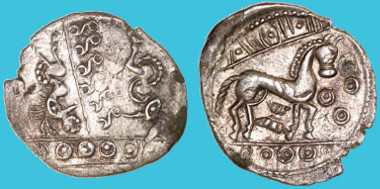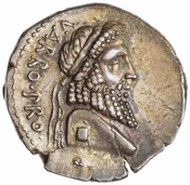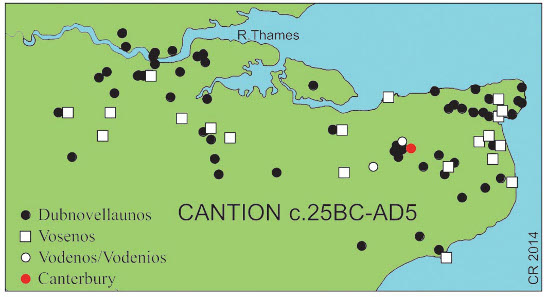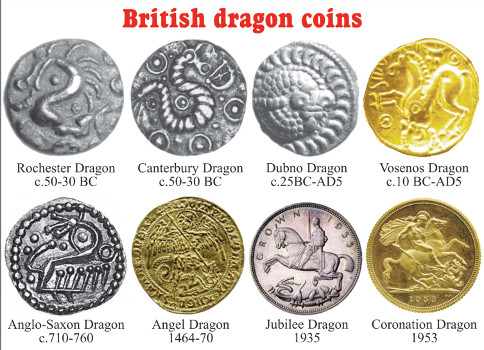by Chris Rudd
On 20 February 2014 an ancient British silver coin of the highest rarity – no others quite like it are known – was unearthed by a metal detectorist near Canterbury in Kent. It was probably struck sometime around the birth of Christ by an obscure Cantian ruler whose name – perhaps Vodenos or Vodenios – is inscribed backwards on a very similar silver coin found at Canterbury in 1953 (see ABC 363).
Vodenos Dragons silver unit, c.10 BC-AD 5. A new type, previously unrecorded. Picture: Chris Rudd.
The sea was of crucial importance to the Cantiaci. Not surprisingly sea creatures and fishing nets occur on many of their coins. The newly discovered Vodenos coin shows what might be described as two sea-dragons divided by a column of seven mini-serpents. I suspect that the dies were cut by an illiterate engraver because the ruler’s name above the horse has become a garbled jumble of pseudo-letters, more decorative than informative.
Pompey the Great silver denarius, 49-48 BC. Prototype of Vodenos Dragons obverse? Source: American Numismatic Society.
The angular design of the obverse is unusual and may have been inspired by a Roman coin. But which? A silver denarius of Pompey the Great, struck 49-48 BC by one of his commanders, Marcus Terentius Varro, is “just about plausible” says Dr Ian Leins, curator of Iron Age and Roman coins at the British Museum. The sea was as important to Pompey as it may have been to Vodenos, which is why there’s a dolphin on Pompey’s denarius.
Vodenos Dragons coin was found near Canterbury. Recorded findspots of Vosenos coins (all gold) are scattered across north Kent with a cluster in east Kent, as are Cantian coins of Dubnovellaunos (all metals). Source: CCI.
Vodenos may (or may not) have been associated with Vosenos, whose gold coins are found across north and east Kent. Some say they may be one and the same person and that Vodenos (or Vodenios) could be a blundered or alternative version of Vosenos. I think that Vosenos may have been a son of Dubnovellaunos who ruled on both sides of the Thames estuary, in Essex as well as Kent.
Dragons have been on British coins for over 2,000 years. Like the Lambton Worm and Loch Ness Monster, they are part of Britain’s folklore. Source: CR, Italo Vecchi, Spink, Baldwins.
Dragons have featured in British myths and legends since the medieval period – perhaps even from prehistoric times – and have occurred on British coins for two-thousand years, from the Rochester Dragon and Canterbury Dragon of c.50-30 BC to St. George and the Dragon on the 1953 coronation proof sovereign of Queen Elizabeth II, sold by Baldwin’s on 8 May, estimate 250,000-300,000 GBP.
The unique Vodenos Dragons coin will be sold by auction in July by Elizabeth Cottam of Chris Rudd, estimate 2,000-3,000 GBP.
For further information contact Elizabeth Cottam via email.
For more information on Chris Rudd and his auctions, please visit his website.
If you are interested in Celtic coins and history, don’t miss our archive!








